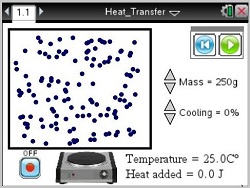Heat Transfer

Heat Transfer
In this lesson, students will investigate a closed system of particles that can be heated or cooled.
- Students will explore a simulation of a closed system of particles that can be heated and then opened to allow the heat to escape from it (cooled).
- Students will vary the mass in the system and observe a change in the number of particles.
- Students will heat the system and observe an increase in the activity of the particles. They will note the changes in color and the increase in the number of Joules added to the system.
- As students release energy from the system they will note a drop in temperature and relate this to the cooling rate.
- Students will relate the changes in temperature to transfers through conduction and convection.
- Students will observe the changes in the system as heat is added AND the system is cooled.
- temperature
- cooling
- convection
- Joule
- heat
- conduction
- radiation
- calorie
- energy
- kinetic energy
- specific heat
In this lesson, students will investigate a closed system of particles that can be heated or cooled. Students may increase or decrease the number of particles in the system and observe the motion and color of these particles as the temperature changes. The material in the box is either a gas or a liquid as the temperature changes. The students will explore the ways that heat is added and removed from the system connecting these to conduction, convection, and radiation.
As a result, students will:
- Explore the relationship between temperature and the energy in the system as shown by the color and motion of the particles.
- Relate the increase in temperature with the number of Joules of energy added.
- Connect the drop in temperature with the cooling rate and the motion and color of the particles in the system.
- Apply the concepts of heat transfer (conduction, convection, and radiation) to the changes in the system of particles.
Vernier EasyData,Vernier EasyLink and Vernier EasyTemp are registered trademarks of Vernier Science Education.

